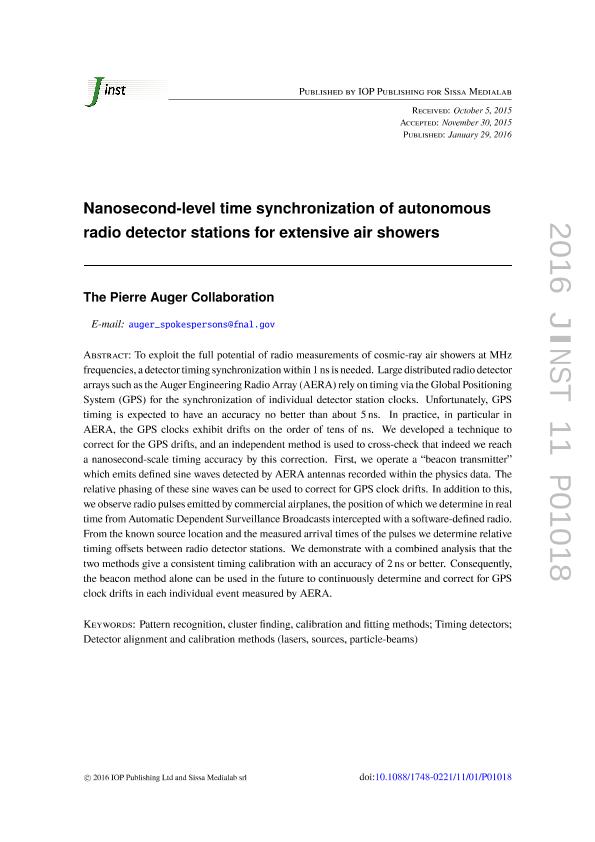Artículo
Nanosecond-level time sinchronization of autonomous radio detector stations using a reference beacon and commercial airplanes.
Aab, A.; Abreu, P.; Aglietta, M.; Ahn, E. J.; Al Samarai, I; Allekotte, Ingomar; Almela, Daniel Alejandro ; Bertou, Xavier Pierre Louis
; Bertou, Xavier Pierre Louis ; Figueira, Juan Manuel
; Figueira, Juan Manuel ; Filevich, Alberto
; Filevich, Alberto ; Garcia, Beatriz Elena
; Garcia, Beatriz Elena ; Golup, Geraldina Tamara
; Golup, Geraldina Tamara ; Gomez Berisso, Mariano
; Gomez Berisso, Mariano ; Gómez Vitale, P. F.; González, N.; Hampel, Matias Rolf
; Gómez Vitale, P. F.; González, N.; Hampel, Matias Rolf ; Hansen, Patricia Maria
; Hansen, Patricia Maria ; Harari, Diego Dario
; Harari, Diego Dario ; Jarne, Cecilia Gisele
; Jarne, Cecilia Gisele ; Mariazzi, Analisa Gabriela
; Mariazzi, Analisa Gabriela ; Melo, Diego Gabriel
; Melo, Diego Gabriel ; Micheletti, Maria Isabel
; Micheletti, Maria Isabel ; Mollerach, Maria Silvia
; Mollerach, Maria Silvia ; Pallotta, Juan Vicente
; Pallotta, Juan Vicente ; Platino, Manuel
; Platino, Manuel ; Quel, E. J.; Ristori, P.; Roulet, Esteban
; Quel, E. J.; Ristori, P.; Roulet, Esteban ; Rovero, Adrian Carlos
; Rovero, Adrian Carlos ; Sanchez, Federico Andrés
; Sanchez, Federico Andrés ; Sato, R.; Scarso, C.; Sciutto, Sergio Juan
; Sato, R.; Scarso, C.; Sciutto, Sergio Juan ; Supanitsky, Alberto Daniel
; Supanitsky, Alberto Daniel ; Taborda Pulgarin, Oscar Alejandro
; Taborda Pulgarin, Oscar Alejandro ; Tapia, A.; Videla, M.; Wahlberg, Hernan Pablo
; Tapia, A.; Videla, M.; Wahlberg, Hernan Pablo ; Wainberg, Oscar Isaac; The Pierre Auger Collaboration
; Wainberg, Oscar Isaac; The Pierre Auger Collaboration
 ; Bertou, Xavier Pierre Louis
; Bertou, Xavier Pierre Louis ; Figueira, Juan Manuel
; Figueira, Juan Manuel ; Filevich, Alberto
; Filevich, Alberto ; Garcia, Beatriz Elena
; Garcia, Beatriz Elena ; Golup, Geraldina Tamara
; Golup, Geraldina Tamara ; Gomez Berisso, Mariano
; Gomez Berisso, Mariano ; Gómez Vitale, P. F.; González, N.; Hampel, Matias Rolf
; Gómez Vitale, P. F.; González, N.; Hampel, Matias Rolf ; Hansen, Patricia Maria
; Hansen, Patricia Maria ; Harari, Diego Dario
; Harari, Diego Dario ; Jarne, Cecilia Gisele
; Jarne, Cecilia Gisele ; Mariazzi, Analisa Gabriela
; Mariazzi, Analisa Gabriela ; Melo, Diego Gabriel
; Melo, Diego Gabriel ; Micheletti, Maria Isabel
; Micheletti, Maria Isabel ; Mollerach, Maria Silvia
; Mollerach, Maria Silvia ; Pallotta, Juan Vicente
; Pallotta, Juan Vicente ; Platino, Manuel
; Platino, Manuel ; Quel, E. J.; Ristori, P.; Roulet, Esteban
; Quel, E. J.; Ristori, P.; Roulet, Esteban ; Rovero, Adrian Carlos
; Rovero, Adrian Carlos ; Sanchez, Federico Andrés
; Sanchez, Federico Andrés ; Sato, R.; Scarso, C.; Sciutto, Sergio Juan
; Sato, R.; Scarso, C.; Sciutto, Sergio Juan ; Supanitsky, Alberto Daniel
; Supanitsky, Alberto Daniel ; Taborda Pulgarin, Oscar Alejandro
; Taborda Pulgarin, Oscar Alejandro ; Tapia, A.; Videla, M.; Wahlberg, Hernan Pablo
; Tapia, A.; Videla, M.; Wahlberg, Hernan Pablo ; Wainberg, Oscar Isaac; The Pierre Auger Collaboration
; Wainberg, Oscar Isaac; The Pierre Auger Collaboration
Fecha de publicación:
01/2016
Editorial:
IOP Publishing
Revista:
Journal of Instrumentation
ISSN:
1748-0221
Idioma:
Inglés
Tipo de recurso:
Artículo publicado
Clasificación temática:
Resumen
To exploit the full potential of radio measurements of cosmic-ray air showers at MHz frequencies, a detector timing synchronization within 1 ns is needed. Large distributed radio detector arrays such as the Auger Engineering Radio Array (AERA) rely on timing via the Global Positioning System (GPS) for the synchronization of individual detector station clocks. Unfortunately, GPS timing is expected to have an accuracy no better than about 5 ns. In practice, in particular in AERA, the GPS clocks exhibit drifts on the order of tens of ns. We developed a technique to correct for the GPS drifts, and an independent method is used to cross-check that indeed we reach a nanosecond-scale timing accuracy by this correction. First, we operate a “beacon transmitter” which emits defined sine waves detected by AERA antennas recorded within the physics data. The relative phasing of these sine waves can be used to correct for GPS clock drifts. In addition to this, we observe radio pulses emitted by commercial airplanes, the position of which we determine in real time from Automatic Dependent Surveillance Broadcasts intercepted with a software-defined radio. From the known source location and the measured arrival times of the pulses we determine relative timing offsets between radio detector stations. We demonstrate with a combined analysis that the two methods give a consistent timing calibration with an accuracy of 2 ns or better. Consequently, the beacon method alone can be used in the future to continuously determine and correct for GPS clock drifts in each individual event measured by AERA.
Palabras clave:
Astroparticles
,
Pierre Auger
,
Clusters
Archivos asociados
Licencia
Identificadores
Colecciones
Articulos(IFLP)
Articulos de INST.DE FISICA LA PLATA
Articulos de INST.DE FISICA LA PLATA
Citación
Aab, A.; Abreu, P.; Aglietta, M.; Ahn, E. J.; Al Samarai, I; et al.; Nanosecond-level time sinchronization of autonomous radio detector stations using a reference beacon and commercial airplanes.; IOP Publishing; Journal of Instrumentation; 11; 1-2016; 1018-1018
Compartir
Altmétricas



